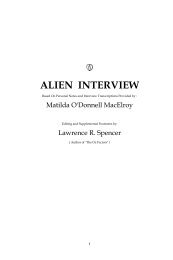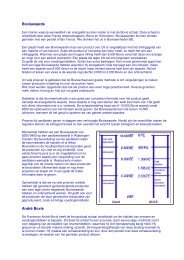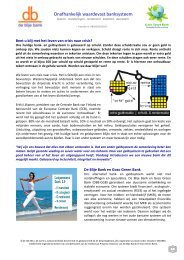De verborgen gevaren van vaccinaties - WantToKnow.nl
De verborgen gevaren van vaccinaties - WantToKnow.nl
De verborgen gevaren van vaccinaties - WantToKnow.nl
You also want an ePaper? Increase the reach of your titles
YUMPU automatically turns print PDFs into web optimized ePapers that Google loves.
Aluminium en de wereldwijde toename <strong>van</strong> dementie<br />
Onderzoeken wijzen uit dat aluminium wereldwijd een potentiële oorzaak is voor de 35<br />
miljoen gevallen <strong>van</strong> dememtie, waaronder de ziekte <strong>van</strong> Alzheimer sterk<br />
oververtegenwoordigd is. Men verwacht dat dit aantal iedere 20 jaar zal verdubbelen tenzij er<br />
een medische doorbraak plaats vindt. Ik vraag me af of daar niet eerder een inzichtelijke<br />
doorbraak voor nodig is – dus een preventie – dan een doorbraak in de behandeling.<br />
Eerder in deze studie repte ik al even over het feit dat er bij de ziekte <strong>van</strong> Alzheimer sprake is<br />
<strong>van</strong> verkeerd verkreukelde (gevouwen) eiwitten en dat de ziekte vn Alzheimer ook steeds<br />
meer wordt gerelateerd aan aluminiumhoudende vaccins. Interessant is ook dat Dr. John<br />
McDougall, MD, aluminium aantrof in het centrum <strong>van</strong> elk <strong>van</strong> de plaques in de hersenen <strong>van</strong><br />
Alzheimerpatiënten.<br />
Recentelijk stuitte ik bij PubMed op twee verschillende onderzoekspublicaties betreffende de<br />
rol <strong>van</strong> elektro-actieve stoffen in relatie tot de ontwikkeling <strong>van</strong> de ziekte <strong>van</strong> Alzheimer.<br />
Ik zal <strong>van</strong> beide artikelen de samenvatting hieronder citeren. Ik begin met het artikel:<br />
Aluminium, iron, zinc and copper influence the in vitro formation of ammyloid fibris of<br />
Abeta42 in a manner which may have consequences for metal chelation therapy in<br />
Alzheimer’s disease, door House E, Collingwood J, Khan A, Korchazkina O, Berthon G,<br />
Exley C. Birchall Centre for Inorganic Chemistry and Materials Science, Keele University,<br />
Staffordshire, UK. (J Alzheimers Dis. 2004 Jun;6(3):291-301).<br />
[…] Metals are found associated with beta-pleated sheets of Abeta42 in vivo and may be<br />
involved in their formation. Metal chelation has been proposed as a therapy for Alzheimer’s<br />
disease on the basis that it may safely dissolve precipitated Abeta peptides. We have followed<br />
fibrillisation of Abeta42 in the presence of an additional metal ion [Al(III), FE(III), ZN(II),<br />
CU(II)] over a period of 32 weeks and we have investigated the dissolution of these aged<br />
peptide aggregates in the presence of both desferrioxamine (DFO) and<br />
ethylenediaminetetraacetic acid (EDTA). Abeta42 either alone or in the presence of Al(III) or<br />
FE(III) formed beta-pleated sheets of plaque-like amyloids which were dissolved upon<br />
incubation with either chelator. Zn(II) inhibited whilst Cu(II) prevented the formation of betapleated<br />
sheets of Abeta42 and neither of these influences were affected by incubation of the<br />
aged peptide aggregates with either DFO or EDTA.<br />
Freshly prepared solutions of Abeta42 either alone or in the presence of added Al(III) or<br />
Fe(II) did not form beta-pleated amyloid in the presence of DFO when incubated for up to<br />
8 weeks.<br />
EDTA did not prevent beta-pleated amyloid formation in the same treatments and promoted<br />
beta-pleated amyloid formation in the presence of either Zn(II) or Cu(II). The presence of<br />
significant concentrations of Al(III) and Fe(III) as contaminants of ‘Abeta42 o<strong>nl</strong>y’<br />
preparations suggested that both of these metals were involved in either triggering the<br />
formation or stabilisising the structure of beta-pleated amyloid. If the formation of such<br />
amyloid is critical to the aetiology of AD then the chelation of Al(III) and Fe(III) may prove to<br />
be a protective mechanism whilst the chelation of Cu(II) and Zn(II) without also chelating<br />
Al(III) and Fe(III) might actually exacerbate the condition […]<br />
Uit dit interessante stukje blijken enkele dingen:<br />
• Aluminium en ijzer kunnen – in vivo - zuiver Abeta42 aanzetten tot plaquevorming.<br />
• Zink en koper doen dit niet.<br />
• <strong>De</strong>ze plaquevorming <strong>van</strong> Abeta42 vindt plaats na minstens 32 weken.<br />
• Blootstelling <strong>van</strong> Abeta42 aan Al of Fe geeft tot 8 weken nog geen waarneembaar effect.<br />
115







